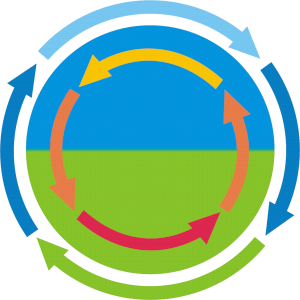A01
Structural controls of soil hydraulic properties
Dr. Sara Bauke
University of Bonn | +49-228-73 2965 |
Prof. Dr. Wulf Amelung
University of Bonn | +49-228-73 2780 |
Summary
The hydraulic conductivity function of soils is a key property, controlling the partitioning of water into soil infiltration and surface runoff as well as the flow of water within the soil profile. Structure is an important factor for hydraulic conductivity in the wet range of soil moisture. However, this is currently not well implemented into land surface models, which typically produces incorrect representations of hydraulic conductivity at and near saturation, erroneous estimates of water partitioning at the soil surface especially in extreme events and thereby a misrepresentation of soil and surface water fluxes in the global water cycle. In this project we therefore assess the effect of soil structure on soil hydraulic conductivity for different climatic, soil and land use settings across Europe. The results are then incorporated into continental-scale modelling of water and energy cycles.
A02
Estimation of root zone soil moisture from gamma radiation measurements
Prof. Dr. J.A. (Sander) Huisman
Forschungszentrum Jülich | +49-2461-618607 |
Summary
Root-zone soil moisture (SM) is an essential variable in land surface models, but there is still a lack of sensing information that adequately represents this zone. The first main hypothesis is that a root-zone SM product for Europe can be derived from existing gamma radiation data from the European radiological data exchange platform (EURDEP). For this, it is important to understand how infiltration, evaporation, transpiration, and secondary cosmic radiation affect measured gamma radiation. This will be achieved with both laboratory and field experiments and the analysis of available gamma radiation time series. The insights obtained will be used to develop data processing strategies and an observation operator that relates SM to gamma radiation. This operator will be coupled to a hydrological model to validate the performance for SM estimation and the improved estimation of soil hydraulic parameters.
A03
Parameterization of evapotranspiration partitioning function in land-surface models using water stable isotopes
Prof. Dr. Youri Rothfuss
Forschungszentrum Jülich | +49-2461-96925 |
Prof. Dr. Nicolas Brüggemann
Forschungszentrum Jülich | +49-2461-618643 |
Summary
In project A03, we analyze water component fluxes of the terrestrial water cycle by partitioning evapotranspiration (ET) into its components evaporation (E) and transpiration (T). The method is based on the non-destructive analysis of the temporal dynamics of water stable isotopologues, 1H2H16O and 1H218O, in atmospheric, soil and plant water. These analysis will be carried out in the ecosystems with four specific plant functional types (PFTs) defined in CLM 5.0: managed irrigated crops, C3 grass, temperate climate needleleaf evergreen trees, and Mediterranean managed rain-fed un-irrigated crops. Using the gathered data, the isotope-enabled soil-vegetation-atmosphere transfer model SiSPAT-Isotope will be parametrized for field-scale simulations of T/ET for the analyzed PFTs and different climatic conditions. These modeling results will be compared to estimations of E and T using the CLM 5.0 and improve the PFT-specific modeling parametrization.
A04
Precipitation processes
PD. Dr. Silke Trömel
University of Bonn | +49-228-73779 |
Summary
Atmospheric models still do not adequately represent precipitation generating processes and previous studies identify cloud and precipitation processes as one of the largest uncertainties in current weather and climate prediction models. This incomplete representation of precipitation generating processes is assumed to be at least partly responsible for their inability to reproduce observed regional patterns of drying and wetting. We compared different precipitation datasets covering the European domain and then evaluated the simulated precipitation and precipitation trends against them. We then aimed to relate the trends in precipitation with trends in terrestrial water storage (from satellite observations and reanalysis) and found significant discrepancies, suggesting complex dynamics which could be linked to glacier melt, topographical influences and/or human water use (i.e., irrigation), and still require further investigation.
We focus on Germany and Türkiye, two countries with contrasting climate regimes and hydrological trends, which are monitored by modern polarimetric radar networks. Microphysical properties such as mean volume diameter (Dm), total number concentration (Nt), and ice/liquid water content (IWC/LWC) were analyzed using contoured frequency-temperature diagrams. Observations show that Dm increases with temperature due to riming and aggregation, Nt decreases toward the melting layer (ML), and IWC and LWC show site-dependent patterns that may be influenced by processes like evaporation, coalescence, and seasonal . Simulations differ from observations by showing fewer but larger particles above the ML and differing IWC gradients, indicating differences in aggregation and riming intensities but potentially also modeling deficiencies, e.g. in the ice nucleating scheme that requires further investigation. Contoured frequency-temperature diagrams of radar moments reveal consistent vertical profiles across German radar sites, while Turkish sites exhibit more variability. Germany shows stronger gradients of reflectivity above the ML, indicating more intense riming and aggregation, with notable seasonal changes across all sites. Stratiform events with dominating riming processes—more frequent in summer and more common in Germany—are associated with higher, colder cloud tops, sagging MLs, and distinct radar signatures, patterns observed consistently across both regions. These observational findings are now being further exploited for model evaluation and improvements. Whether the regional differences are influenced by anthropogenic interventions in the land-atmosphere system remains to be investigated also with supporting scenario simulations.
A05
Representation of adaptation: the on-farm perspective
Prof. Dr. Silke Hüttel
University of Bonn | +49 551 39-24846 |
Prof. Dr. Michael Leyer
University of Marburg | +49 6421 28-23382 |
Dr. Stefan Seifert
University of Göttingen | +49 551 39-24841 |
Summary
In A05, we aim at an improved representation of how farmers adapt to climate change, altering weather (extremes), production risk and efficiency, and ultimately expectations on farming returns. Yet to date, farms seem reluctant to adapt their farming structure. Based on the real options approach, we hypothesize that this reluctance can be explained by farms’ investment behavior under risk and various sources of inefficiency. We test this hypothesis using observational data. To understand underlying cognitive decision processes under extreme hydrometeorological events, we test the impact of such perceived instances on farm adaptation decisions using an experimental approach.
A06
Processes and determinants of climate-relevant landscape configurations
Prof. Dr. Jan Börner
University of Bonn | +49-228-733548 |
Prof. Dr. Thomas Heckelei
University of Bonn | +49-228-732332 |
Prof. Dr. Silke Hüttel
University of Göttingen | +49 551 39-24851 |
Summary
In this project, we explore the effects of changes in land cover composition and configuration on climate in the CRC study area. Our focus lies on the processes and economic consequences of changes in the composition and configuration of landscape elements that regulate coupled land and atmospheric water and energy cycles. These elements include the abundance and spatial arrangement of crops, forests, and grasslands. Using coupled regional climate models, we assess the climate impacts of land cover composition and configuration spatiotemporal patterns, and apply econometric methods to causally link these compositional and configurational shifts to economic outcomes.

